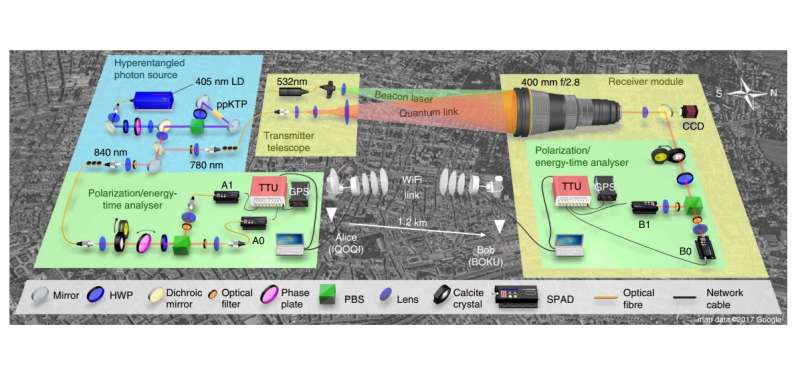August 23, 2017 feature
Hyperentanglement across roof tops paves the way toward a global quantum Internet

(Phys.org)—For the first time, physicists have demonstrated that hyperentangled photons can be transmitted in free space, which they showed by sending many thousands of these photons between the rooftops of two buildings in Vienna. Hyperentanglement means that the photons are simultaneously entangled in at least two different properties—in this experiment, the researchers combined two two-dimensionally entangled properties to achieve four-dimensional hyperentanglement.
By showing that hyperentanglement transmission is feasible in the real world and not only in the lab, the physicists expect that the demonstration could one day be scaled up to establish a highly secure quantum Internet that uses satellites to quickly and securely transmit quantum information across the globe.
The physicists, led by Rupert Ursin at the Institute for Quantum Optics and Quantum Information (IQOQI) at the Austrian Academy of Sciences in Vienna, have published a paper on the distribution of hyperentanglement via atmospheric free-space links in a recent issue of Nature Communications.
Hyperentangled states have several advantages over states with only one entangled property, including higher data rates and improved levels of security in quantum communication. So far, however, experiments involving hyperentanglement have only been demonstrated in protected laboratory environments across short distances. The ability to transmit hyperentangled states via optical free-space links will allow for transmission over longer distances than is possible using optical fibers on the ground.
As the physicists explain, the simplest type of entanglement between photons is polarization entanglement. When measured, a photon will exhibit one of two polarization states (vertical or horizontal), producing two-dimensional entanglement in the polarization degree of freedom. In two-dimensional polarization encoding, each photon is restricted to encoding at most one qubit.
But there are other ways to entangle photons, and these methods can be combined with polarization entanglement to achieve hyperentangled photons, which have the potential to store multiple qubits.
In the new work, the physicists combined polarization entanglement with a second kind of entanglement called energy-time entanglement, which involves the emission time of the photon pair and can take on many possible values, resulting in many higher dimensions. In this experiment, for technical reasons, the physicists used only two particular emission times, "early" and "late," corresponding to two degrees of freedom. When combined, the two types of entanglement enabled the researchers to create four-dimensional hyperentangled states.
"We encoded qubits in two properties of the photon simultaneously," coauthor Fabian Steinlechner at the Austrian Academy of Sciences told Phys.org. "We encoded one qubit in the well-studied polarization degree of freedom, and another in the time-energy degree of freedom, which had not yet been shown to withstand transmission via a turbulent free-space link. This way we doubled the amount of entanglement per photon compared to previous experiments over real-world optical links. Increasing the dimensionality of entanglement and transmitting high-dimensional entanglement under real-world atmospheric link conditions is an important step towards more efficient and practical quantum communication systems."
The hyperentangled photon source, which generates pairs of hyperentangled photons, was located in a laboratory at the IQOQI in Vienna. To demonstrate hyperentanglement distribution, the researchers stored one photon from each hyperentangled pair at the lab and sent the other photon in each pair through an optical fiber to a transmitter telescope on the roof of the building. The telescope then transmitted that photon in free space to a receiver on the roof of another building located 1.2 km away, which collected the photons and verified their hyperentanglement.
Although atmospheric turbulence caused the transmission efficiency of the hyperentangled photons to vary, and approximately half of the distributed photons were lost due to absorption by the optical components, the researchers still successfully detected about 20,000 photon pairs per second. The results demonstrate, for the first time, the feasibility of using energy-time/polarization hyperentanglement in real-world conditions. The researchers are now looking forward to developing applications that harness the advantages of hyperentanglement.
"Hyperentanglement, simultaneous entanglement in multiple degrees of freedom, can be used to encode several entangled qubits per photon," said coauthor Sebastian Ecker at the Austrian Academy of Sciences. "We refer to this as high-dimensional entanglement. Increasing the dimensionality of entanglement promises higher data rates and improved levels of security in quantum cryptography, since attempts to copy high-dimensional quantum states result in larger errors compared to two-dimensional encoding, thus making it easier to detect an eavesdropper. Furthermore, certain transformations are easier to accomplish when quantum states are encoded in several degrees of freedom, which can make quantum information processing protocols, such as quantum teleportation and dense coding, easier to implement in practice."
In the future, the physicists hope to increase the dimensionality far beyond four dimensions, pushing the amount of quantum information that can be transmitted by a single photon to its ultimate limits. This could significantly boost the data rates in future satellite experiments.
"In our experiment, we used two dimensions of the time-energy space," Steinlechner said. "However, unlike polarization, time-energy entanglement is not fundamentally limited to two possible states and its potential dimensionality is orders of magnitudes larger."
If hyperentanglement can be transmitted higher up in space, it would also open up possibilities for new kinds of fundamental physics experiments. These could include investigating gravity-induced collapse of the wave function and quantum information processing under relativistic conditions.
More information: Fabian Steinlechner et al. "Distribution of high-dimensional entanglement via an intra-city free-space link." Nature Communications. DOI: 10.1038/ncomms15971
Journal information: Nature Communications
© 2017 Phys.org





















